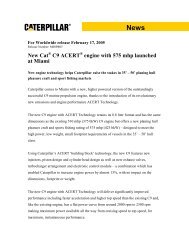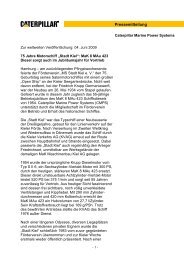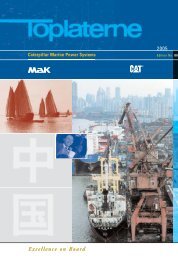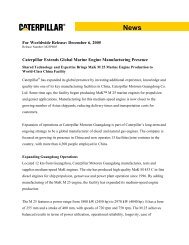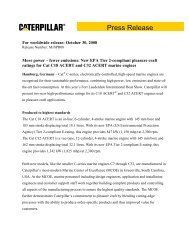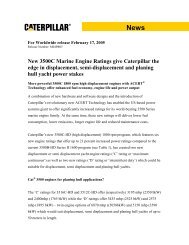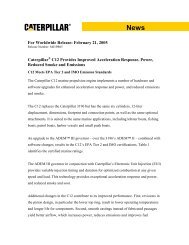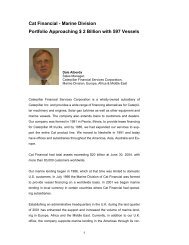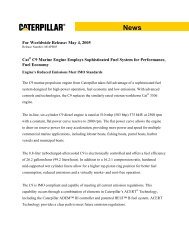Caterpillar Marine - Marine Engines Caterpillar
Caterpillar Marine - Marine Engines Caterpillar
Caterpillar Marine - Marine Engines Caterpillar
Create successful ePaper yourself
Turn your PDF publications into a flip-book with our unique Google optimized e-Paper software.
MaK M 43 C engines for the „AIDAdiva“<br />
First engine quartet delivered<br />
to Meyer Werft<br />
Following the delivery of the first<br />
two MaK 9 M 43 C engines from<br />
<strong>Caterpillar</strong> Motorenwerk Rostock<br />
to Meyer Werft in Papenburg in April, a<br />
further two engines of this type were<br />
delivered to the German cruise ship<br />
specialist after passing their acceptance<br />
test in early June. All four engines<br />
of the propulsion plant for the “AID-<br />
Adiva”, the first of four new AIDA club<br />
ships planned, are thus at the yard.<br />
Keeping to an ambitious schedule, the<br />
impressive engine quartet has meanwhile<br />
been installed in the engine room<br />
of the “AIDAdiva” that is taking shape.<br />
The “Sphinx” project<br />
With this project, <strong>Caterpillar</strong> <strong>Marine</strong><br />
Power Systems is taking another great<br />
step forward with its long-term strategy<br />
in the cruise ship segment. A year<br />
ago, Meyer Werft signed the contract<br />
for four MaK 9 M 43 C engines for<br />
installation in the next generation of<br />
AIDA cruise ships. It decided to cooperate<br />
with <strong>Caterpillar</strong> <strong>Marine</strong> after carrying<br />
out a detailed analysis of rival<br />
systems, with special attention being<br />
paid to a low sound level, high reliability<br />
and low pollutant emissions. In late<br />
summer 2005, AIDA Cruises – a subsidiary<br />
of Costa Crociere, itself owned by<br />
the market leader Carnival Corporation<br />
– decided to order a third vessel of the<br />
“Sphinx” class. On the occasion of its<br />
tenth anniversary on June 12th 2006,<br />
AIDA Cruises then placed an order for<br />
a fourth sister ship from Meyer Werft.<br />
Work on the first vessel began in October<br />
2005, and the keel-laying ceremony<br />
was held in Papenburg on March 3rd<br />
2006. The “AIDAdiva” is due for delivery<br />
on April 15th 2007 – after a construction<br />
time of 400 days. The other three<br />
ships are to follow in 2008, 2009 and<br />
2010 respectively.<br />
Each newbuilding has a length of<br />
252m and a beam of 32.2m and provides<br />
1,025 cabins, accommodating<br />
a total of 2,050 passengers. The propulsion<br />
system comprises four MaK<br />
engines 9 M 43 C with an overall output<br />
of 36,000 kW, driving two single propel-<br />
lers via electric motors as well as two<br />
bow thrusters and two stern thrusters.<br />
The plant also generates the electricity<br />
for all other high-consumption<br />
systems on board, such as the airconditioning<br />
plant, hotel/restaurant facilities<br />
and the state-of-the-art wellness<br />
area. There is also, of course, adequate<br />
engine performance for the propulsion<br />
of the 68,500 gt newbuildings, which<br />
have a top speed of 21 knots.<br />
Tailor-made propulsion plant<br />
To ensure higher engine reliability,<br />
AIDA opted for a specially adapted<br />
design of the M 43 C. This offers as<br />
additional features:<br />
n<br />
n<br />
n<br />
n<br />
A slow turning device for reliable<br />
engine remote starting<br />
A connecting rod bearing temperature<br />
monitoring system to prevent the<br />
bearings seizing up<br />
Advanced resilient engine mounting<br />
to minimise engine vibrations and<br />
their transmission on to the hull and<br />
The DICARE monitoring system, permitting<br />
users to call up engine operating<br />
data at any time, even from shore<br />
For cruise ship operation, it is also<br />
very important that each of the MaK<br />
9 M 43 C engines features the Flexible<br />
Camshaft Technology (FCT). This proven<br />
element of <strong>Caterpillar</strong>’s ACERTTM technology<br />
was developed to keep soot particle<br />
emissions over the entire load area<br />
AI DA-Newbuilding<br />
With its appearance and its concept the vessels of the “Sphinx” class will surely<br />
inspirit the international market of cruise vessels<br />
below the optical perception limit and<br />
reduce NOx emissions to well below<br />
the IMO limit values.<br />
Test passed<br />
These additional functions of MaK<br />
9 M 43 C engines specially envisaged<br />
for AIDA Cruises were accordingly the<br />
focus of attention for customer acceptance.<br />
Representatives of AIDA Cruises,<br />
Meyer Werft, Germanischer Lloyd, Carnival<br />
Corporate Shipbuilding and the<br />
<strong>Caterpillar</strong> dealer Zeppelin/MaK Deutschland<br />
attended the two-day test<br />
run on the engine stand at <strong>Caterpillar</strong><br />
Motoren Rostock.<br />
After two very busy days, all the necessary<br />
measurement results were<br />
finally available. All the participants<br />
approved the concluding report of the<br />
acceptance test for the MaK 9 M 43<br />
C, which yielded extraordinarily positive<br />
results. The new vibration dampers<br />
proved to be very effective, the engines<br />
started even with very low available<br />
air pressure and the Flexible Camshaft<br />
Technology of MaK proved to be highly<br />
successful in reducing soot particle<br />
emissions.<br />
Delighted customers<br />
“Flawless, clean design with very<br />
good access to all main components,”<br />
was how Chris Joly, Principal Manager –<br />
9



